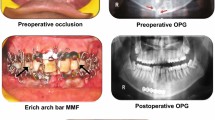Abstract
Introduction
Maxillomandibular fixation is required in nearly all cases of facial fractures which can be achieved by conventional dental wiring techniques or newer methods using transalveolar screws.
Material and Methods
A prospective randomized clinical study divided into two groups with thirty adult patients each with mandibular fractures was undertaken comparing the Maxillomandibular fixation technique using transalveolar screws and Erichs arch bar. Total time taken, rate of glove perforation, intraoperative and postoperative complications were noted in both the groups.
Results
The time taken for maxillomandibular fixation in minutes and rate of glove perforation was found to be statistically significantly less for transalveolar group compared to arch bar group (p < 0.05). However, there was no significant difference found in the oral hygiene and gingival status using the Glass index and Gingival index. The rate of screw breakage (04.67%), wire breakage (05.12%), non-vitality due to iatrogenic dental damage (01.66%), soft tissue injury and tooth loss were some of the noted complications during the study.
Conclusion
We found that transalveolar group offered advantages like less time taken with a definite decreased risk of percutaneous injury, while the iatrogenic complications like dental damage can be reduced by taking adequate precautions.


Similar content being viewed by others
References
Arthur G, Berardo N (1989) Asimplified technique of maxillomandibular fixation. J Oral Maxillofac Surg 47:1234
European Committee for Standarization. Medical gloves for single use Part 1: requirements for testing for freedom from holes. EN455-1:1993E
Peter S (2000) Essentials of preventive and community dentistry, 1st edn. Arya Publishing House, New Delhi, pp 478–479
Peter S (2000) Essentials of preventive and community dentistry, 1st edn. Arya Publishing House, New Delhi, pp 472–474
Karlis V, Glickman R (1997) An alternative to arch bar maxillomandibular fixation. Plast Reconstr Surg 99:1758–1759
Sahoo NK, Mohan R (2010) INF screw: an ideal intermaxillary fixation device during open reduction of mandibular fractures. J Maxillofac Oral Surg 9(2):170–172
Rowe NL, Williams JL (1994) Maxillofaccial injuries, 2nd edn. Churchill Livingstone, London
Schneider AM, David LR, De Franzo AJ, Marks MW, Molnar JA, Aegenta LC (2000) Use of specialized bone screws for intermaxillary fixation. Ann Plast Surg 44:154–157
Avery CM, Taylor J, Johnson PA (1999) Double gloving and a system for identifying glove perforations in maxillofacial trauma surgery. Br J Oral Maxillofac Surg 37:316–319
Gaujac C, Ceccheti MM, Yonezaki F, Garcia IR, Peres MP (2007) Comparative analysis of 2 techniques of double—gloving protection during arch bar placement for intermaxillary fixation. J Oral Maxillofac Surg 65:1922–1925
Avery CM, Johnson PA (1992) Surgical glove perforation and maxillofacial trauma: to plate or wire? Br J Oral Maxillofac Surg 30:31–35
Gordon KF, Reed JM, Anand VK (1995) Results of intracortical bone screws fixation technique for mandibular fractures. Otolaryngol Head Neck Surg 113:248–252
Imazawa T, Komuro Y, Inove M et al (2003) Mandibular fractures treated with MMFS method. J Craniofac Surg 17:544; 3:159–161
Bali R, Sharma P, Garg A (2011) Incidence and patterns of needle stick injuries during intermaxillary fixation. Br J Oral Maxillfac Surg 49:221–224
Anshul R (2014) A simplified method of preventing needle stick type injury to the operators finger while performing intermaxillary fixation. J Maxillofac Oral Surg 13(2):215–216
Anshul R, Datarkar A, Boorle R (2009) Customised screw for IMF for maxillofacial injuries. Br J Oral Maxillofac Surg 47:325–326
Fabbroni G, Aabed S, Mizen K, Starr DG (2004) Transalveolar screws and the incrdence of dental damage: a prospective study. Int J Oral Maxillofac Surg 33:442–446
Widar Fredrik, Kashani Hossein, Kanaraja Sanjiv, Dahlin Chister, Ramusson Lars (2012) A retroseptive evaluation of iatrogenic dental root damage with predrilled vs drill free bone anchor screws for IMF. Dent Traumatol 28:127–131
Hartwig S, Andreas B, Christian D, Voss JO, Moritz H, Saskia P, Raguse JD (2016) Drill related root injury caused by intraoperative intramaxillary fixation: an analysis of, 1067 screw applications. Dent Traumatol. doi:10.1111/edt.12305
Bins A, Oomens MAE, Boffano P, Forouzanfar T (2015) Is there enough evidence to regularly apply bone screws for intermaxillary fixation in mandibular fractures. J Oral Maxillofac Surg 73:1963–1969
Alves M Jr, Baratieri C, Araeyo MTS, Souza MMG, Mania LC (2012) Root damage associated with intermaxillary screws: a systemic review. Int J Oral Maxillofac Surg 41:1445–1450
Florence VA, Kofod T, Pinhott EM (2016) Intermaxillary fixation screw morbidity in treatment of mandibular fractures-a retrospective study. J Oral Maxillofac Surg 74:1800–1806
Bai Z, Gao Z, Xiao X, Zhang W, Fan X, Wang Z (2015) Application of IMF screws to assist rigid fixation of jaw fractures: our experience of 168 cases. Int J Clin Exp Pathol 8(9):11565–11568
Author information
Authors and Affiliations
Corresponding author
Ethics declarations
Conflict of interest
The author declares that they have no conflict of interest.
Ethical Approval
Study has been approved by the institutional ethic committee.
Informed consent
All patients in the study have given informed consent to participate in the study.
Rights and permissions
About this article
Cite this article
Sandhu, Y.K., Padda, S., Kaur, T. et al. Comparison of Efficacy of Transalveolar Screws and Conventional Dental Wiring Using Erich Arch Bar for Maxillomandibular Fixation in Mandibular Fractures. J. Maxillofac. Oral Surg. 17, 211–217 (2018). https://doi.org/10.1007/s12663-017-1046-3
Received:
Accepted:
Published:
Issue Date:
DOI: https://doi.org/10.1007/s12663-017-1046-3




